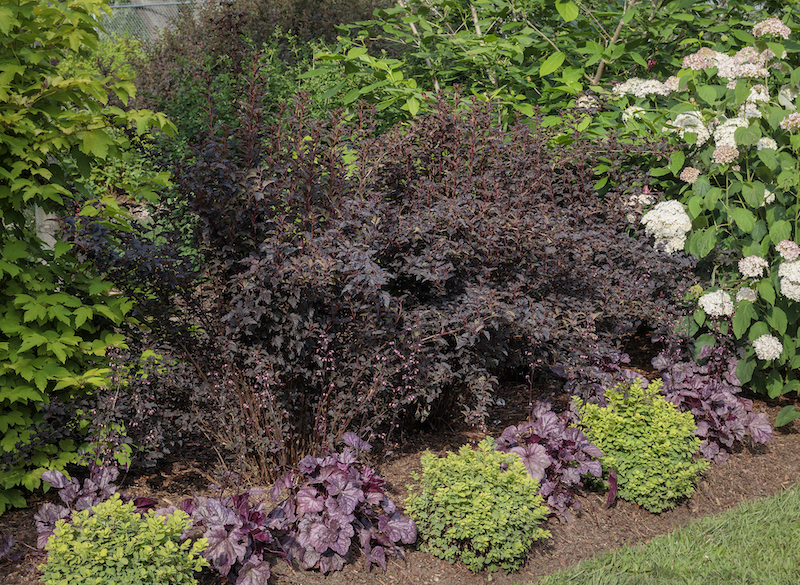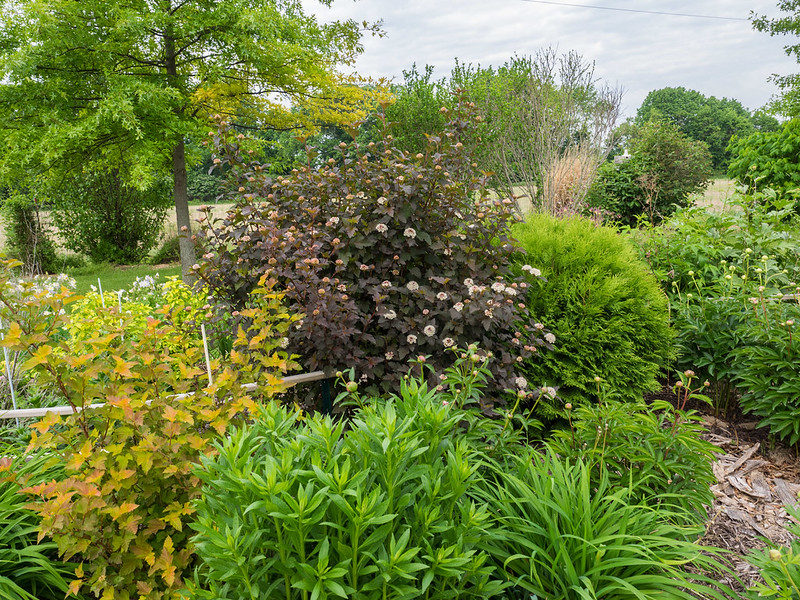Ninebark is one of the most underutilized shrubs for the home garden. It has four seasons of interest and works well as the main structure for a mixed perennial and shrub border. Many varieties have brilliantly colored summer and fall foliage in chartreuse, purple, orange or black hues. Ninebarks bloom in summer with sprays of flowers that develop into bright berries. These features along with exfoliating bark that ages into luxurious shades of gray and brown all add up to one irresistible shrub.
The growing requirements for ninebark are not demanding and fit the needs of many other plants. Ninebark prefers average, well-draining soil, a pH that is slightly acidic or neutral, and plenty of sunshine. Ninebarks tolerate partial shade but will display brighter foliage color in more sun. These are good shrubs for southern climates because they also tolerate long periods of drought and heat.

Shrubs To Plant With Ninebark
Ninebarks look great planted as part of an informal hedge with other ornamental or native shrubs. For bold color, consider red twig dogwood, spirea, viburnum, witch hazel, and sumac, which enjoy the same growing conditions as ninebark. Other flowering shrubs like lilac, sweetshrub, hydrangea, and tree peonies grow well with ninebark and will complement its natural mounded shape and add texture.
Perennials To Plant With Ninebark
Perennials make great partners with ninebark, especially in smaller gardens that may not have enough room for more than one or two large shrubs. Choose herbaceous perennials that bloom either earlier than ninebark or later to extend the flowering season. Early spring blooming perennials like foam flowers, columbine, low-growing windflowers, and peonies look lovely with a backdrop of moody, dark ninebark leaves. For a naturalistic planting, consider adding bluestar, crocosmia, bee balm, salvias, and perennial verbena, which bloom well into the fall. Some of these perennials (particularly bluestar, peonies, and crocosmia) display stunning foliage color as they die back in the fall.

Photo by F. D. Richards, unmodified, Flickr, copyright CC BY-SA 2.0 DEED
Annuals To Plant With Ninebark
Ninebark shrubs grow best in lean soil with minimal added fertilizer. The best annuals to grow with ninebarks are those that readily set seed and require little supplemental fertilizing. Some standouts include cosmos, all types of poppies, love-in-a-mist, calendula, and bronze leaf fennel, which all thrive in well-draining soil with a low nutrient profile. The taller annuals like cosmos and fennel provide contrasting shape and texture and should be positioned closer to the ninebarks at the back of the border. Lower-growing calendula, poppies, and love-in-a- mist make nice edging plants placed near pathways or sidewalks.
Best Companion Plants For Ninebark in Containers
Ninebark shrubs are not usually grown in containers due to their overall size and relatively quick growth. There are a few dwarf-sized types that will grow for many years in large containers with other plants. Pot ninebarks with other pollinator plants such as tickseed, bee balm, hardy geranium, and aster for a container garden focused on supporting wildlife.
Growing perennials and shrubs for long periods in pots is only successful when the containers have excellent drainage all year round. In the winter, prop planters and pots on bricks or dedicated “pot feet” that allow excess water to drain away from the base. Repotting once every 2-3 years will be necessary to refresh the planting medium and prune out any damaged or dead roots.
Plants Not To Grow With Ninebark
Ninebark is tolerant of seasonally wet soils and heavy clay, making it a great companion for most plants. These shrubs will also grow in semi-shaded spots, but deep shade will encourage diminish foliage color and growth. Avoid planting ninebark with plants that thrive in mostly shade like Japanese forest grass, bear's breeches (brunnera), and ferns. These plants require shelter from direct sun during the hottest part of the day and are likely to burn unless shaded by ninebark.
Best Plants To Grow With Ninebark
Ninebarks are fantastic planted in a landscape alongside other native perennials and shrubs. Informal hedges that include spirea, snowberry, ocean spray, and red twig dogwoods are easy to grow and maintain, while providing color 12 months of the year. Plant lower-growing perennials like coral bells, hostas, yarrow, coreopsis, and coneflowers in front to camouflage any bare stems and give your garden a lush and polished appearance.
 |
Author Robbin Small - Published 10-19-2023 |
